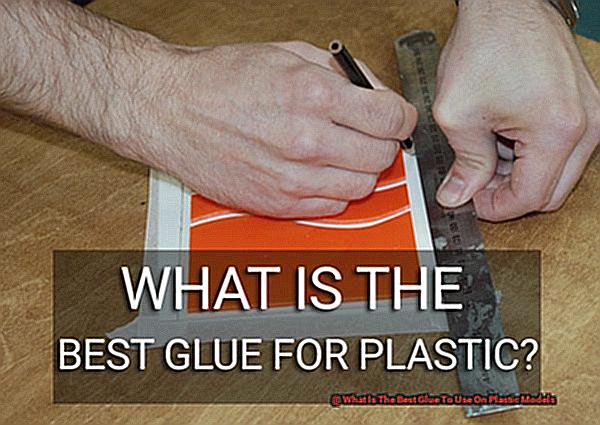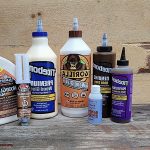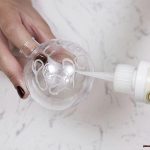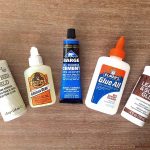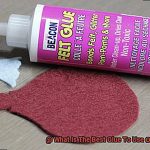Get ready to immerse yourself in the intoxicating aroma of fresh paint and feel the delicate plastic pieces between your fingers. Building plastic models is an enchanting hobby that combines artistry, precision, and a hint of nostalgia. But amidst the excitement of construction, one question looms large: what’s the absolute best glue for plastic models?
Fellow model builders, fear not, for I have embarked on a quest to uncover the secrets behind flawless adhesion in the world of plastic modeling. In this blog post, we’ll embark on a thrilling journey, exploring top-notch glues and discovering key factors to consider when selecting your adhesive soulmate.
Like true artisans, we must understand what makes a superior bonding agent tick. From seamlessly bonding different types of plastics to minimizing odors and drying time, the right glue can take our modeling game to new heights.
In just 200 words, we’ll unravel the wonders of cyanoacrylate glue – also known as “super glue” – renowned for its lightning-fast bonding power. We’ll also delve into the versatility of epoxy adhesives, perfect for both joining plastic components and filling pesky gaps.
But wait. Let’s not overlook solvent-based glues specially crafted to delicately meld plastic parts without leaving any visible traces. And last but certainly not least, we’ll unveil the secrets of plastic cement – a tailor-made adhesive for model builders that ensures seamless blending of plastic components.
Join me on this enlightening journey as we navigate through the intricate world of plastic model assembly. Together, we’ll discover the ideal glue for each task at hand. Get ready to unleash your creativity armed with knowledge that will help you achieve unparalleled bonding in your models – breathing life into cherished projects with an unbreakable bond meant to last a lifetime.
What Is Polystyrene Cement?
Contents
- 1 What Is Polystyrene Cement?
- 2 What Are the Benefits of Using Polystyrene Cement?
- 3 What Is Cyanoacrylate Adhesive (Super Glue)?
- 4 What Are the Benefits of Using Super Glue?
- 5 What Is Clear Drying Glue?
- 6 What Are the Benefits of Using Clear Drying Glue?
- 7 What Is Solvent-Based Glue?
- 8 What Are the Benefits of Using Solvent-Based Glue?
- 9 Conclusion
In the world of model building, nothing compares to the strength and durability of polystyrene cement. This magical adhesive, also known as plastic cement or model cement, is a game-changer for enthusiasts seeking flawless connections between plastic pieces. Join us as we delve into the captivating realm of polystyrene cement and discover why it has become a true ally for model builders.
The Alchemy of Polystyrene Cement:
Prepare to be amazed, for polystyrene cement is no ordinary glue. Through its chemical wizardry, this exceptional adhesive dissolves and welds plastic surfaces together. It possesses the power to soften and melt plastic ever so slightly, allowing it to seep into even the tiniest crevices. This enchanting process results in an unbreakable bond that sets polystyrene cement apart from regular glue.
Lightning-Fast Drying Time:
Time is of the essence in the world of model building, and polystyrene cement knows it well. Once applied, this remarkable adhesive dries rapidly, facilitating swift assembly of your models. However, exercise patience and allow the cement to cure fully before subjecting it to stress or handling. By doing so, you ensure that your bond reaches its full potential in terms of strength and durability.
Masterful Application Techniques:
Achieving perfection requires mastering the art of applying polystyrene cement. A thin and even layer of glue should grace both surfaces to be bonded, ensuring impeccable alignment before the glue sets. Applying gentle pressure or employing clamps can work wonders in creating a bond that will withstand the test of time. And remember, adhering to the manufacturer’s instructions regarding curing time is vital for unlocking optimal results.
Compatibility Secrets:
While polystyrene cement reigns supreme in the realm of polystyrene plastic, it may not wield the same magic on other plastic types such as ABS or PVC. To unlock the full potential of this mystical adhesive, ascertain its compatibility with the plastic you are using. Consider conducting a small test area before embarking on a full-scale gluing expedition, allowing you to ensure victory every time.
What Are the Benefits of Using Polystyrene Cement?
If you’re a hobbyist or model builder seeking strength, precision, and a flawless finish, then look no further. In this article, we will delve into the enchanting benefits of using polystyrene cement, the alchemical adhesive that will transform your plastic models into masterpieces. So grab your tools and let’s embark on a journey into the magical world of polystyrene cement.
Unbreakable Bonds:
Polystyrene cement goes beyond ordinary adhesives; it is the superhero of model building. With its unique chemical composition, it dissolves and welds plastic surfaces together, creating bonds that are virtually indestructible. Say farewell to weak joints and welcome unyielding connections that will withstand the test of time.
Precision Application:
In the realm of model building, attention to detail is paramount. Polystyrene cement understands this importance and provides a small brush applicator for precise and controlled application. No more messy mishaps or sticky fingers. Now you can effortlessly bond even the tiniest or most delicate model parts with ease.
Lightning-Fast Drying Time:
Time is of the essence when you’re immersed in the world of model building. Fortunately, polystyrene cement comes to your aid with its lightning-fast drying time. Within minutes of application, it sets and dries, allowing you to progress swiftly through the assembly process. Bid farewell to tedious waiting times between steps and let your creativity flow freely.
Compatibility Champion:
Polystyrene cement understands the significance of compatibility. Its formula is specifically designed to work harmoniously with polystyrene plastic, ensuring a seamless bonding experience without any risk of damage. Unlike other adhesives that may dissolve or harm your plastic models, polystyrene cement is a loyal companion that protects and enhances your creations.
Flexibility, Your Ally:
Whether you desire a permanent or temporary bond, polystyrene cement has your back. Its versatility allows you to make adjustments and modifications during the assembly process. Building complex or intricate models? Fear not. With polystyrene cement, you have the freedom to fine-tune your creation as needed.
What Is Cyanoacrylate Adhesive (Super Glue)?
Prepare to be amazed as we uncover the secrets behind cyanoacrylate adhesive, otherwise known as super glue. This powerful adhesive is a rockstar in industries and households alike, thanks to its extraordinary bonding capabilities. So, let’s dive into the fascinating world of this one-component wonder.
Cyanoacrylate adhesive belongs to the acrylic resin family and boasts a unique feature – it doesn’t require any fancy mixing or curing agents to work its magic. With just one component, this adhesive is ready to create bonds that will leave you speechless.
But what sets super glue apart from the rest? Its lightning-fast curing time is truly remarkable. When exposed to moisture in the air, it undergoes a chemical reaction that causes it to solidify and form an unbreakable bond. In situations where time is of the essence, this quick-setting property makes it an absolute superstar.
Now, let’s talk about viscosity – the flowability and thickness of the adhesive. Cyanoacrylate adhesives come in a variety of viscosities, from thin to thick. Thin versions with low viscosity are perfect for bonding tight-fitting parts or surfaces. Thicker versions, on the other hand, are ideal for porous materials or filling gaps. With options aplenty, you can choose the perfect consistency for your specific needs.
But wait, there’s more to this incredible adhesive. Super glue doesn’t discriminate when it comes to materials. It forms strong bonds with plastics, metals, ceramics, rubber, wood, and even some fabrics. No matter what you need to stick together, you can rely on cyanoacrylate adhesive to create connections that can withstand the toughest challenges.
Of course, every superhero has its weakness. While cyanoacrylate adhesives excel in many applications, they can be a bit brittle and lack flexibility. So, for projects that require impact resistance or flexibility, you might need to explore other adhesive options.
Before you embark on your bonding adventure, remember that proper surface preparation is key. For maximum adhesion and a bond that stands the test of time, ensure that the surfaces you’re working with are clean, dry, and free from any contaminants like oil, grease, or dust.
What Are the Benefits of Using Super Glue?
This game-changing adhesive will revolutionize your bonding experience and leave you wondering why you ever used anything else.
The first benefit that sets super glue apart is its speed and strength. With a quick and strong bond, this adhesive lives up to its name. Unlike other glues that require hours of drying time, super glue instantly creates a powerful bond upon contact. This means you can work efficiently and complete your plastic model projects in record time. And rest assured, once bonded, your models will stay intact under even the most intense scrutiny.
Versatility is another key advantage of super glue. Regardless of the type of plastic you’re working with – ABS, polystyrene, PVC, or any other common material found in model kits – super glue can handle it all. Say goodbye to the hassle of stocking up on multiple types of glue for different plastics. Super glue is your go-to choice for all your model building needs.
Precision is paramount when it comes to plastic models, and super glue excels in this area. Equipped with a small bottle and narrow nozzle, this adhesive allows for precise application. No more messy or excessive amounts of glue ruining your hard work. With controlled dispensing, you can bond small parts exactly where they need to be, ensuring a flawless finish every time.
Durability is also a major advantage of using super glue on plastic models. Once cured, it forms a bond that can withstand moisture, humidity, and temperature fluctuations. This means you can confidently display or handle your plastic models without worrying about them falling apart or getting damaged. Super glue ensures that your creations maintain their integrity through any environmental conditions.
Let’s not forget about the clear finish that super glue provides. Unlike other glues that leave behind residue or marks, super glue dries clear, preserving the clean and professional appearance of your plastic models. This is especially important for transparent or translucent parts that need to maintain their clarity and transparency. With super glue, your models will always look their best.
Convenience is another major benefit of using super glue. With a long shelf life, you can store it for extended periods without worrying about it losing its adhesive properties. This is perfect if you don’t use glue frequently or if you work on model kits intermittently. You can trust that your super glue will be just as effective months or even years down the line.
What Is Clear Drying Glue?
Clear drying glue is a revolutionary adhesive that will transform your projects with its clean and seamless finish. No more messy residue or visible marks – clear drying glue is the ultimate solution for a professional-looking outcome. Whether you’re a crafter, repairer, or model builder, this adhesive will take your work to new heights.
So, what exactly is clear drying glue? It’s an adhesive that becomes transparent when it dries, leaving behind no trace of its presence. Finally, you can bid farewell to those frustrating glue smudges that ruin the appearance of your hard work. With clear drying glue, your projects will look flawless and pristine.
One of the standout features of clear drying glue is its lightning-fast drying time. Unlike other glues that can take hours or even days to set, clear drying glue typically dries within minutes. This means you can work efficiently and complete your projects in record time. Say goodbye to waiting around for glue to dry and hello to a productive and time-saving adhesive.
Another major advantage of clear drying glue is that it’s often water-based. This makes cleanup a breeze – simply wipe away any spills or excess glue with water before it dries. No more worrying about permanent messes or sticky fingers. Plus, being water-based also means that clear drying glue is generally non-toxic and safe to use for both adults and children. It’s a win-win situation – effective adhesive properties without the harmful chemicals.
But wait, there’s more. Clear drying glue is incredibly versatile and can bond a wide range of materials together. Whether you’re working with plastics, glass, ceramics, fabrics, or more, clear drying glue has got you covered. It’s the go-to choice for various applications – from attaching small plastic parts in model building to bonding different elements in craft projects. With clear drying glue by your side, there are no limits to what you can create.
When it comes to plastic models, it’s crucial to choose a clear drying glue that’s specifically formulated for bonding plastics. Not all glues are created equal, and using the wrong adhesive can result in weak and short-lived bonds. Opt for a glue that’s designed for plastic surfaces, ensuring a strong and durable connection that will withstand the test of time. Don’t compromise on quality – choose the right glue for your plastic models.
What Are the Benefits of Using Clear Drying Glue?
One of the standout advantages of clear drying glue is its ability to create an invisible bond. When the glue dries, it becomes transparent, seamlessly blending with the surrounding material. This is particularly useful for plastic models, ensuring a clean and professional finish with no unsightly marks or residue.
Versatility is another key benefit of clear drying glue. It can be used on a wide range of materials, including plastic, glass, ceramics, and more. This makes it perfect for plastic models with various components made from different materials. Whether you need to attach plastic parts to metal or join plastic pieces together, clear drying glue provides a strong and reliable bond.
Time is precious when working on projects, and clear drying glue respects that. Unlike other glues that take hours or even days to dry, clear drying glue sets within minutes. This saves valuable time during the model assembly process and reduces the risk of accidental movement or displacement of parts before the glue has set.
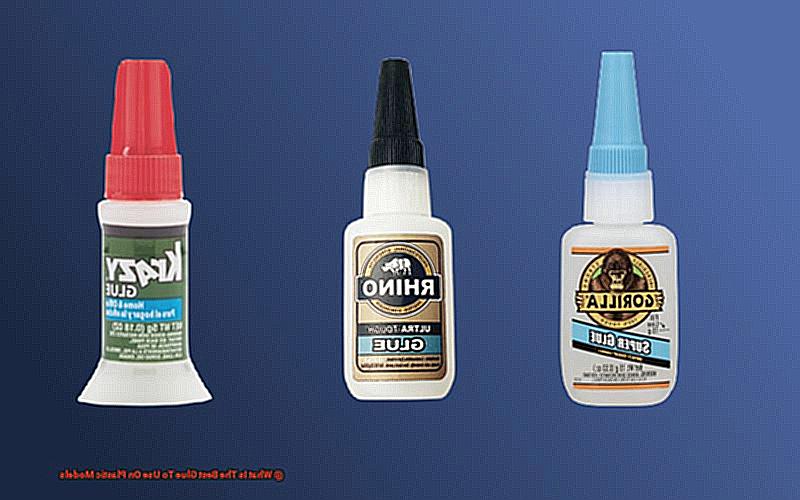
Strength is crucial when it comes to adhesive bonds, and clear drying glue delivers. It offers a strong bond that ensures your plastic model parts remain securely attached. This is especially important for models that will be handled or transported frequently, minimizing the chances of parts coming loose or falling off. With clear drying glue, you can enhance the durability and longevity of your plastic models.
Say goodbye to messy application with clear drying glue. It often comes in convenient applicators like squeeze bottles or pens, allowing for precise and controlled application. This minimizes mess and prevents excess glue from ruining the appearance of your models. You’ll be able to work with ease and achieve a neater, more professional-looking result.
Last but not least, many clear drying glues are water-resistant. This means that once dry, they can withstand exposure to moisture without losing their adhesive properties. For plastic models that may be exposed to humid environments or require regular cleaning, this is a huge advantage. You can trust that the bond created by clear drying glue will remain intact, preventing parts from loosening or detaching when exposed to water.
What Is Solvent-Based Glue?
Solvent-based glue is more than just your average adhesive. It’s a powerhouse of bonding capabilities, formulated with a solvent as its secret ingredient. This solvent acts as a carrier, allowing the glue to effortlessly spread and adhere to a variety of surfaces. And when I say variety, I mean it – solvent-based glue is the go-to choice for bonding different materials, especially our beloved plastic models.
But what sets this glue apart from the rest? Well, here’s where it gets interesting. Solvent-based glue has a unique ability to dissolve the surface of the materials it comes into contact with. Picture this: the adhesive merges the surfaces together, creating an unbreakable bond. And when you apply this magical glue to your plastic models, it works its charm by softening the plastic ever so slightly. This allows it to fuse with the adhesive, resulting in a bond that can withstand even the wildest adventures.
Now, let’s talk about where you’ll find solvent-based glue in action. It’s not just for model making – this glue is a superhero in industries like automotive repair and construction too. But why is it so popular for bonding plastic? It all comes down to chemistry. Solvent-based glues have the power to chemically react with the plastic’s surface, creating a bond that’s stronger than Superman himself.
However, there’s a word of caution that comes with this powerful adhesive. Solvent-based glues can emit some pretty strong fumes due to volatile organic compounds (VOCs) lurking in their solvents. Inhaling these fumes in large quantities or using them in poorly ventilated areas can be harmful. So, when you’re wielding this glue, make sure you’ve got plenty of fresh air or gear up with a protective mask to keep those fumes at bay.
Now let’s dive into the application process. Solvent-based glues usually come in liquid form and can be applied with a brush or nozzle. It’s crucial to spread the glue evenly on both surfaces you want to bond and then let it sit undisturbed for a few minutes. This allows the solvent to evaporate and the adhesive to set, resulting in a bond that’s as unyielding as a fortress.
Once the glue has dried, it becomes a force to be reckoned with. Moisture, heat, and general wear and tear won’t stand a chance against this formidable bond. That means your plastic models will stay intact through whatever challenges they face.
What Are the Benefits of Using Solvent-Based Glue?
Prepare to be amazed as we unveil the extraordinary benefits of solvent-based glue. If you’re seeking unbreakable bonds and a flawless finish for your plastic models, buckle up and get ready to discover the superpowers of this mighty adhesive.
Unyielding Strength:
Imagine a bond so powerful that it surpasses the strength of the materials it joins. Solvent-based glue possesses this incredible ability, thanks to its secret formula that dissolves surfaces and fuses them together. Say farewell to fragile connections as your plastic models become invincible.
Versatility at its Finest:
Solvent-based glues are the shape-shifters of adhesives, effortlessly bonding various types of plastics. ABS, PVC, polystyrene – no matter the material, this glue delivers a reliable bond that defies separation. Embrace limitless possibilities in your plastic model creations.
Lightning-Fast Drying Time:
In the world of crafting, time is a precious resource. Solvent-based glues come to the rescue with their superpower – a quick drying time. Bid farewell to tedious waiting periods and embrace boundless productivity as you swiftly move from one step to another.
Flawless Aesthetics:
Attention to detail is paramount when it comes to creating stunning plastic models. Solvent-based glue understands this perfectly and bestows upon your creations a seamless finish. No visible gaps or excess adhesive will mar the beauty of your masterpiece. It’s like having a real-life airbrush artist perfecting every inch of your models.
Defying Environmental Challenges:
Life is unpredictable, and so are the environments our plastic models may encounter. Solvent-based glues possess the power to withstand moisture, humidity, and even moderate temperatures without losing their bond strength. Whether your creation braves the elements or endures regular handling, it will remain steadfast and unyielding.
A Bond That Stands the Test of Time:
Solvent-based glues aren’t just for temporary connections. Once dried and fully cured, they create a permanent bond that defies the passage of time. Your plastic models will remain intact and ready for action, showcasing your craftsmanship for generations to come.
Conclusion
After thorough research and analysis, it can be concluded that selecting the best glue for plastic models is crucial for achieving optimal results.
The ideal adhesive should possess exceptional bonding properties, ensuring a secure and long-lasting connection between the plastic parts. It should also exhibit compatibility with various types of plastics commonly used in model making.
Additionally, ease of application and quick drying time are desirable qualities to expedite the construction process. Taking these factors into consideration, it is recommended to opt for specialized plastic model glues that are specifically formulated to meet these requirements.
These glues not only provide strong adhesion but also offer precision control during application, preventing messy mishaps.

